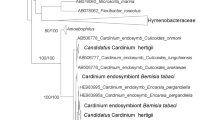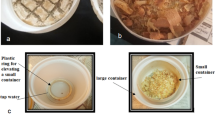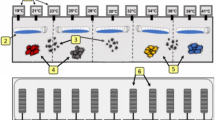Abstract
Dermatophagoides farinae is an important house dust mite species that causes allergies in humans worldwide. In houses, these mites are commonly found in actively used mattresses and pillows, which provide food (i.e. sloughed skin and microorganisms), moisture, and increased temperature for faster mite development. In mattresses, feeding mites prefer the upper sector, as close as possible to the resting human (temperature 32–36 °C, humidity between 55 and 59%). However, mites that are not actively feeding prefer staying at deeper zones of the mattress. Here, we analyzed mite responses to different temperatures (15–35 °C) and relative humidity (62–94% RH) in terms of their population size growth and respiration (CO2 production) using lab mite cultures. The intrinsic rate of population increase had a single maximum at approximately 28 °C and 85% RH. At 30 °C, there were two respiration peaks at RH 90% (smaller peak) and 65% (larger peak). Therefore, there is a mismatch between the optimal temperature/humidity for the population size increase vs. respiration. We propose preliminary hypotheses explaining the two respiration peaks and suggest that future research should be done to elucidate the nature of these peaks.




Similar content being viewed by others
References
Alexander A, Fall N, Arlian L (2002) Mating and fecundity of Dermatophagoides farinae. Exp Appl Acarol 26:79–86. https://doi.org/10.1023/A:1020920320439
Arlian LG (1992) Water balance and humidity requirements of house dust mites. Exp Appl Acarol 16:15–35. https://doi.org/10.1007/BF01201490
Arlian LG, Dippold JS (1996) Development and fecundity of Dermatophagoides farinae (Acari: Pyroglyphidae). J Med Entomol 33:257–260. https://doi.org/10.1093/jmedent/33.2.257
Arlian LG, Veselica MM (1981) Reevaluation of the humidity requirements of the house dust mite Dermatophagoides farinae (Acari: Pyroglyphidae). J Med Entomol 18:351–352. https://doi.org/10.1093/jmedent/18.4.351
Arlian LG, Rapp CM, Ahmed SG (1990) Development of Dermatophagoides pteronyssinus (Acari: Pyroglyphidae). J Med Entomol 27:1035–1040
Arlian LG, Confer PD, Rapp CM, Vyszenski-Moher DL, Chang JCS (1998) Population dynamics of the house dust mites Dermatophagoides farinae, D. pteronyssinus, and Euroglyphus maynei (Acari: Pyroglyphidae) at specific relative humidities. J Med Entomol 35:46–53. https://doi.org/10.1093/jmedent/35.1.46
Arlian LG, Neal JS, Vyszenski-Moher DL (1999a) Fluctuating hydrating and dehydrating relative humidities effects on the life cycle of Dermatophagoides farinae (Acari: Pyroglyphidae). J Med Entomol 36:457–461. https://doi.org/10.1093/jmedent/36.4.457
Arlian LG, Neal JS, Vyszenski-Moher DL (1999b) Reducing relative humidity to control the house dust mite Dermatophagoides farinae. J Allergy Clin Immunol 104:852–856. https://doi.org/10.1016/s0091-6749(99)70298-8
Aspaly G, Stejskal V, Pekar S, Hubert J (2007) Temperature-dependent population growth of three species of stored product mites (Acari: Acaridida). Exp Appl Acarol 42:37–46. https://doi.org/10.1007/s10493-007-9074-1
Blythe ME (1976) Some aspects of the ecological study of the house dust mites. Br J Dis Chest 70:3–31. https://doi.org/10.1016/0007-0971(76)90003-6
Calderon MA, Linneberg A, Kleine-Tebbe J, De Blay F, de Rojas DHF, Virchow JC, Demoly P (2015) Respiratory allergy caused by house dust mites: what do we really know? J Allergy Clin Immunol 136:38–48. https://doi.org/10.1016/j.jaci.2014.10.012
Colloff MJ (1987) Effects of temperature and relative humidity on development times and mortality of eggs from laboratory and wild populations of the European house-dust mite Dermatophagoides pteronyssinus (Acari: Pyroglyphidae). Exp Appl Acarol 3:279–289. https://doi.org/10.1007/BF01193165
Colloff MJ (1998) Distribution and abundance of dust mites within homes. Allergy 53:24–27. https://doi.org/10.1111/j.1398-9995.1998.tb04992.x
Colloff MJ (2009) Dust mites, 1st edn. CSIRO Publishing, Collingwood, VIC. https://doi.org/10.1007/978-90-481-2224-0
Crowther D, Horwood J, Baker N, Thomson D, Pretlove S, Ridley I, Oreszczyn T (2000) House dust mites and the built environment: a literature review. Report for the EPSRC project “A Hygrothermal Model for Predicting House-Dust Mite Response to Environmental Conditions in Dwellings”. The Bartlett, University College London, London. https://www.ucl.ac.uk/bartlett-housedustmites/Publications/Publications/review10Oct02.pdf. Accessed 3 Aug 2022
Crowther D, Wilkinson T, Biddulph P, Oreszczyn T, Pretlove S, Ridley I (2006) A simple model for predicting the effect of hygrothermal conditions on populations of house dust mite Dermatophagoides pteronyssinus (Acari: Pyroglyphidae). Exp Appl Acarol 39:127–148. https://doi.org/10.1007/s10493-006-9003-8
Cunningham MJ (1998) Direct measurements of temperature and humidity in dust mite microhabitats. Clin Exp Allergy 28:1104–1112. https://doi.org/10.1046/j.1365-2222.1998.00351.x
de Boer R, Kuller K (1997) Mattresses as a winter refuge for house-dust mite populations. Allergy 52:299–305. https://doi.org/10.1111/j.1398-9995.1997.tb00994.x
Dobson RM (1980) Some effects of microclimate on the longevity and development of Dermatophagoides pteronyssinus (Trouessart). Acarologia 21:482–486
Erban T, Hubert J (2008) Digestive function of lysozyme in synanthropic acaridid mites enables utilization of bacteria as a food source. Exp Appl Acarol 44:199–212. https://doi.org/10.1007/s10493-008-9138-x
Erban T, Klimov P, Molva V, Hubert J (2020) Whole genomic sequencing and sex-dependent abundance estimation of Cardinium sp., a common and hyperabundant bacterial endosymbiont of the American house dust mite. Dermatophagoides Farinae Exp Appl Acarol 80:363–380. https://doi.org/10.1007/s10493-020-00475-5
Gamal-Eddin FM, Abou-Sinna FM, Tayel SE, Aboul-Atta AM, Seif AM, Gaafar SM (1983a) Duration of the development stages of house dust mites Dermatophagoides farinae and D. pteronyssinus under controlled temperatures and relative humidities to pave the way in front of the workers in the field of house-dust mite bronchial asthma. 1. Pre-imaginal period. J Egypt Soc Parasitol 13:319–334
Gamal-Eddin FM, Shehata KK, Abou-Sinn FM, Tayel SE, Aboul-Atta AM, El-Ahmedaawy BA, Fayed MA, Hafez AH, Imam MH (1983b) Duration of the developmental stages of house dust mites D. farinae and D. pteronyssinus under controlled conditions to pave the way in front of the workers in the field of house-dust mite asthmatic bronchitis. 3—Larval duration. J Egypt Soc Parasitol 13:583–595
Gamal-Eddin FM, Shehata KK, Tayel SE, Abou-Sinna FM, Aboul-Atta AM, Seif AI, Imam MH, Hafez AH (1983c) Duration of the developmental stages of house-dust mites Dermatophagoides farinae and D. pteronyssinus under controlled conditions, to pave the way in front of the workers in the field of house-dust mite asthmatic bronchitis. 2 — Oviposition period, fecundity and oval duration. J Egypt Soc Parasitol 13:557–581
Gamal-Eddin FM, Abou-Senna FM, Tayel SE, Seif AM (1983d) Longevity of adult mites in the laboratory as determinal factor in indicating the peaks of environment pollution with house dust mite allergens. J Egypt Soc Parasitol 13:31–41
Hay DB, Hart BJ, Douglas AE (1993) Effects of the fungus Aspergillus penicillioides on the house dust mite Dermatophagoides pteronyssinus: an experimental re-evaluation. Med Vet Entomol 7:271–274. https://doi.org/10.1111/j.1365-2915.1993.tb00687.x
Hubert J, Pekar S, Nesvorna M, Sustr V (2010) Temperature preference and respiration of acaridid mites. J Econ Entomol 103:2249–2257. https://doi.org/10.1603/EC10237
Hubert J, Nesvorna M, Kopecky J, Erban T, Klimov P (2019) Population and culture age influence the microbiome profiles of house dust mites. Microb Ecol 77:1048–1066. https://doi.org/10.1007/s00248-018-1294-x
Hubert J, Nesvorna M, Klimov PB, Erban T, Sopko B, Dowd SE, Scully ED (2021) Interactions of the intracellular bacterium Cardinium with its host, the house dust mite Dermatophagoides farinae, based on gene expression data. mSystems 6:e0091621. https://doi.org/10.1128/mSystems.00916-21
Klimov P, Molva V, Nesvorna M, Pekar S, Shcherbachenko E, Erban T, Hubert J (2019) Dynamics of the microbial community during growth of the house dust mite Dermatophagoides farinae in culture. FEMS Microbiol Ecol 95:fiz153. https://doi.org/10.1093/femsec/fiz153
Matsumoto K, Okamoto M, Wada Y (1986) Effect of relative humidity on life cycle of the house dust mites, Dermatophagoides farinae and D. pteronyssinus. Med Entomol Zool 37:79–90. https://doi.org/10.7601/mez.37.79. (in Japanese with English Summary)
Molva V, Nesvorna M, Hubert J (2019) Feeding interactions between microorganisms and the house dust mites Dermatophagoides pteronyssinus and Dermatophagoides farinae (Astigmata: Pyroglyphidae). J Med Entomol 56:1669–1677. https://doi.org/10.1093/jme/tjz089
Murton JJ, Madden JL (1977) Observations on the biology, behaviour and ecology of the house-dust mite, Dermatophagoides pteronyssinus (Trouessart) (Acarina: Pyroglyphidae) in Tasmania. Aust J Entomol 16:281–287. https://doi.org/10.1111/j.1440-6055.1977.tb00104.x
Naegele A, Reboux G, Scherer E, Roussel S, Millon L (2013) Fungal food choices of Dermatophagoides farinae affect indoor fungi selection and dispersal. Int J Environ Health Res 23:91–95. https://doi.org/10.1080/09603123.2012.699029
Nesvorna M, Pekar S, Shcherbachenko E, Molva V, Erban T, Green SJ, Klimov PB, Hubert J (2021) Microbiome variation during culture growth of the European house dust mite, Dermatophagoides pteronyssinus. FEMS Microbiol Ecol 97:fiab039. https://doi.org/10.1093/femsec/fiab039
Pekar S, Brabec M (2019) Moderni analyza biologickych dat. 3. dil, Nelinearni modely v prostredí R [Modern analysis of biological data. Volume 3, Non-linear models in R]. Masaryk University Press, Brno (in Czech)
Petrova-Nikitina AD, Antropova AB, Bilanenko EN, Mokeeva VL, Chekunova LN, Bulgakova TA, Zheltikova TM (2011) Population dynamics of mites of the family Pyroglyphidae and micromycetes in laboratory cultures. Entomol Rev 91:377–387. https://doi.org/10.1134/S0013873811030134
Pretlove SEC, Ridley I, Horwood JA, Leung B, Cox P, Thomson D, Baker N, Crowther D, Oreszczyn T (2001) A combined transient hygrothermal and population model of house dust mites in beds. In: IAQ 2001: moisture, microbes and health effects: indoor air quality and moisture in buildings, ASHRAE, San Francisco, USA, 4–7 November 2001
R Core Team (2021) R: a language and environment for statistical computing. R Foundation for Statistical Computing, Vienna, Austria. http://www.R-project.org. Accessed 26 July 2021
Ree HI, Lee IY, Kim TE, Jeon SH, Hong CS (1997) Mass culture of house dust mites, Dermatophagoides farinae and D. pteronyssinus (Acari: Pyroglyphidae). Med Entomol Zool 48:109–116. https://doi.org/10.7601/mez.48.109
Rezk HA (2004) Influence of temperature on life history parameters of the American house dust mite, Dermatophagoides farinae Hughes (Acari: Pyroglyphidae). Alex J Agric Res 49:25–31
Rodriguez D, Palacios R, Martinez J, Guisantes JA, Postigo I (2021) Kinetics of Dermatophagoides pteronyssinus and Dermatophagoides farinae growth and an analysis of the allergen expression in semi-synthetic culture medium. Acarologia 61:403–411. https://doi.org/10.24349/acarologia/20214439
Roth S, MacDonald EP, Lindroth RL (1997) Atmospheric CO2 and soil water availability: consequences for tree-insect interactions. Can J For Res 27:1281–1290. https://doi.org/10.1139/x97-031
Saleh SM, Abdel-Hamid MM, Rezk HA (1991) Biology of the European house dust mite, Dermatophagoides pteronyssinus (Trouessart). Acarologia 32:57–60
Schowalter TD (2006) Insect ecology: an ecosystem approach, 2nd edn. Elsevier, Amsterdam
Spieksma FTM (1967) The house-dust mite Dermatophagoides pteronyssinus (Trouessart, 1897), producer of the house-dust allergen (Acari: Psoroptidae). N.V. Drukkerij V/H Batteljee & Terpstra, Leiden
Thomas WR (2010) Geography of house dust mite allergens. Asian Pac J Allergy Immunol 28:211–224
Vackova T, Pekar S, Klimov PB, Hubert J (2021) Sharing a bed with mites: preferences of the house dust mite Dermatophagoides farinae in a temperature gradient. Exp Appl Acarol 84:755–767. https://doi.org/10.1007/s10493-021-00649-9
Van Asselt L (1999) Interactions between domestic mites and fungi. Indoor Built Environ 8:216–220. https://doi.org/10.1177/1420326X9900800402
van Bronswijk JEMH, Sinha RN (1971) Pyroglyphid mites (Acari) and house dust allergy: a review. J Allergy Clin Immunol 47:31–52. https://doi.org/10.1016/S0091-6749(71)80315-9
Vrtala S (2022) Allergens from house dust and storage mites. Allergo J Int 31:267–271. https://doi.org/10.1007/s40629-022-00226-5
WHO/IUIS (2022) Allergen nomenclature: allergen TreeView. WHO/IUIS Allergen Nomenclature Sub-Committee. http://www.allergen.org/treeview.php. Accessed 26 Aug 2022
Wood SN (2006) Generalized additive models: an introduction with R, 1st edn. CRC Press, Boca Raton, FL
Yella L, Morgan MS, Arlian LG (2013) Population growth and allergen accumulation of Dermatophagoides farinae cultured at 20 and 25 °C. Exp Appl Acarol 60:117–126. https://doi.org/10.1007/s10493-012-9626-x
Acknowledgements
The authors are obligated to two anonymous referees for useful comments of previous version of draft. We thank Martin Markovic for excellent technical help.
Funding
The study was supported by the Ministry of Agriculture of the Czech Republic, institutional support MZE-RO0423. PBK was supported by the Ministry of Science and Higher Education of the Russian Federation within the framework of the Federal Scientific and Technical Program for the Development of Genetic Technologies for 2019–2027 (Agreement No. 075-15-2021-1345, unique identifier RF – 193021X0012) to A. V. Lisitsa.
Author information
Authors and Affiliations
Contributions
TV provided the experiment, TV and JH designed the experiment, SP analyzed the data and TV, JH, SP and PBK participated in the scientific writing.
Corresponding author
Ethics declarations
Competing interests
The authors declare no competing interests.
Additional information
Publisher's Note
Springer Nature remains neutral with regard to jurisdictional claims in published maps and institutional affiliations.
Rights and permissions
Springer Nature or its licensor (e.g. a society or other partner) holds exclusive rights to this article under a publishing agreement with the author(s) or other rightsholder(s); author self-archiving of the accepted manuscript version of this article is solely governed by the terms of such publishing agreement and applicable law.
About this article
Cite this article
Vackova, T., Pekar, S., Klimov, P.B. et al. Population growth and respiration in the dust mite Dermatophagoides farinae under different temperature and humidity regimes. Exp Appl Acarol 89, 157–169 (2023). https://doi.org/10.1007/s10493-022-00775-y
Received:
Accepted:
Published:
Issue Date:
DOI: https://doi.org/10.1007/s10493-022-00775-y




